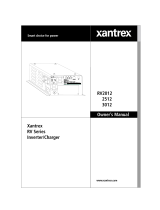
SOLAR Power Inverter USER’S MANUAL
6
Installation
Things to Remember When Planning Your Installation
Please read this section on power inverter installation in its entirety before beginning the installation process. There
are many things to consider that will have a bearing on both the safety and performance of your power inverter and
power delivery system.
While your power inverter is specified and advertised to deliver a range of continuous power to an upper limit
threshold, all aspects of your power system must support the inverter reaching full power. The decisions you make
about your power delivery system components and design will directly impact your ability to get the most out of
your power inverter, both in the short and long term.
It is important that you consider your specific application and design your power inverter system to meet the needs
of your application. It is also important that you ensure that you are in compliance with all local, state and national
codes governing your installation
(See Installation Code Compliance).
Throughout this section, you may want to refer to the Power Inverter Installation Schematic on page 11 for an
example of a typical installation.
Installation Code Compliance
Your power inverter is a serious piece of equipment and should be used only by those competent to install and
operate it. In certain applications, installation and operation will be governed by local, state or national codes.
These codes will vary based on your locale and on your particular installation location and application. It is your
responsibility to ensure that you are compliant with all such codes. Failure to follow these codes may result in
personal injury or property damage.
Battery Types, Sizes and Inverter Power Requirements
Note: Your power inverter is designed to be connected to a 12 Volt Power Source (12 Volt battery or batteries).
Do not connect your power inverter to either a 6 Volt battery or a 24 Volt battery configuration. Doing so will
damage the power inverter and could cause personal injury or property damage!
Choosing the Right Battery Type
One of the most important determinants of the success of your installation is your choice of DC power source.
What types of batteries should be used? How large should they be? How many are needed? Your choice of battery
type and total battery capacity can have a serious impact on your system performance and ability to successfully
and repeatedly perform the desired applications.
The most common battery type is the standard, or conventional, flooded acid starting battery, which is used in most
of today’s passenger vehicles. While this type of battery could be successfully used in certain power inverter
systems, it is not the recommended battery for this application. This is because most power inverter system
applications will cause the battery(ies) used to undergo deep discharge/recharge cycles in the course of normal
operation. Standard flooded acid starting batteries do not last long under such use, as they are typically designed
to deliver a very fast “starting” burst of power (which does not result in a deep discharge) to start a vehicle and are
then immediately recharged by the vehicle’s charging system.
The preferred battery type for a power inverter system application is a cycling battery, sometimes referred to as a
deep cycle battery, marine battery or RV battery. Cycling batteries are designed to be used in deep discharge/
recharge cycling applications without affecting their longevity or performance.
Please note that, when you are using more than one battery to meet your power source needs to power the inverter
(see Determining Battery Capacity Needs), you should take care to ensure that all of the batteries used are
matching in terms of manufacturer, battery type, capacity, state of charge, etc. This ensures the system will perform
in a stable manner and that recharging will distribute the charge equally among the batteries being used. In
situations where multiple batteries are connected in series, parallel or series/parallel, replacement batteries should
be the same size, type and manufacturer (if possible). Age and usage level should be the same as the companion
batteries. Do not put a new battery in a group that is more than 3 months old or has more than 75 cycles. Either
replace with all new or use a good used battery.






















